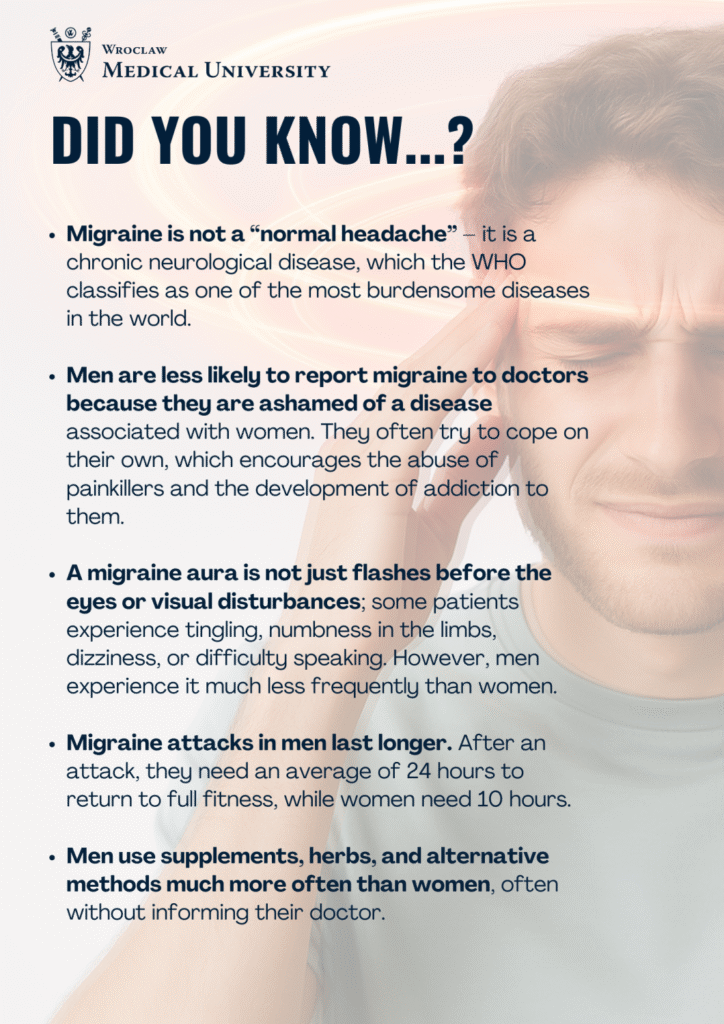When we talk about migraine, we usually picture a woman in a dark room, holding her head, in pain that prevents her from functioning normally. Statistics confirm that migraine does indeed mainly affect women. It occurs up to three times more often in women than in men. But does this mean that men can rest easy? The latest research conducted in Poland shows that migraine in men has its specific characteristics, and their experiences differ significantly from those of women.
The most extensive study in Poland
A team of scientists led by Dr. Marta Waliszewska-Prosół from the Department of Neurology at Wroclaw Medical University conducted a nationwide study entitled “Migraine in Poland.”
More than 3,000 people struggling with headaches took part in the study, including nearly 1,700 people with confirmed migraines. More than 3,000 people suffering from headaches took part in the study, including almost 1,700 people with confirmed migraine. It is one of the most extensive studies of its kind in Central Europe. The authors decided to take a closer look at men, a group that is often marginalized in migraine research.
Different symptoms, different problems
As Dr. Marta Waliszewska-Prosół, the lead author of the publication, emphasizes, the differences are obvious:
Our study showed that the phenotype of migraine attacks differs between women and men. Men are less likely than women to report visual and sensory aura symptoms, but are more likely to report other symptoms preceding an attack, such as anxiety, fatigue, pathological yawning, or irritability. The post-attack phase, i.e., the time it takes to return to normal functioning after an attack, is also significantly longer in men, averaging 24 hours, compared to 10 hours in women. This means that migraine attacks in men are longer and often more severe, which was a surprise to us, as this has not been described in the global literature to date, says Dr. Waliszewska-Prosół.
This means that men remain excluded from professional and family life for longer, and migraine, although less frequently diagnosed, can be particularly burdensome for them.
Silent and delayed treatment
The results of the study also showed significant differences in the ways migraine is treated. Women are more likely to use preventive therapies and specialist care, while men are more likely to use temporary painkillers – often on their own and without consulting a doctor. Dr. Marta Waliszewska-Prosół emphasizes that this is influenced by social conditions and stereotypical perceptions of the role of men: Men suffering from migraine are ashamed of their headaches, which stems from stereotypical perceptions of masculinity, in which there is no room for weakness, which is what headaches are considered to be. Most often, they suffer in silence, secretly and, over time, in increasing amounts, because they have to function in life and at work. They frequently visit a doctor after many years, when they are entirely unable to cope with everyday life.
This approach contributes to the development of a vicious circle of pain. The disease progresses, and at the same time, the problem of painkiller abuse grows. Codeine-based preparations are hazardous, as they are readily available without a prescription and are often abused in Poland.
Education and awareness – the key to change
Migraine is still often underestimated, and in the case of men, it is met with even less understanding.
“There is a prevailing view that migraine is a women’s disease, most scientific research focuses on migraine from the perspective of women only, and men usually constitute a small and scientifically insignificant control group,” says Dr. Waliszewska-Prosół.
She emphasizes that educational and systemic measures are needed to enable men to obtain a correct diagnosis more quickly. “Migraine is a marginalized disease in both sexes, both by the system and by decision-makers, which should be emphasized and changed, but in the case of men, it is met with even less understanding and acceptance,” she points out.
Surprising findings
One of the conclusions that surprised the researchers the most was how much money men spend on treatment.
We were quite surprised by the fact that men abuse painkillers more often than women, become addicted more easily, but also try to save themselves with dietary supplements much more often. As a result, they spend significantly more money on migraine treatment than women, comments Dr. Waliszewska-Prosół.
This shows that the disease often goes unnoticed: men experiment with various methods, including so-called alternative ones, without always informing their doctors about what they are using.
Migraine do not discriminate
The “Migraine in Poland” study has shown for the first time so clearly that migraine in men is a serious yet marginalized problem. Differences in symptoms, treatment, and patient attitudes suggest that a more personalized approach is needed. Education, both for patients and doctors, can help break stereotypes, shorten the time to diagnosis, and break the vicious cycle of self-medication.
“We still have a lot of work ahead of us to bring migraine out of the shadows so that it can be treated,” concludes Dr. Waliszewska-Prosół.

This material is based on an article:
Migraine in men – differences in phenotype and treatment patterns: results from the Migraine in Poland cross-sectional national survey
Authors: Marta Waliszewska-Prosół, Karol Marschollek, Sławomir Budrewicz, Mieszko Więckiewicz, Magdalena Nowaczewska & Marcin Straburzyński
DOI: 10.1186/s10194-025-02117
__________________________________________________________________________________